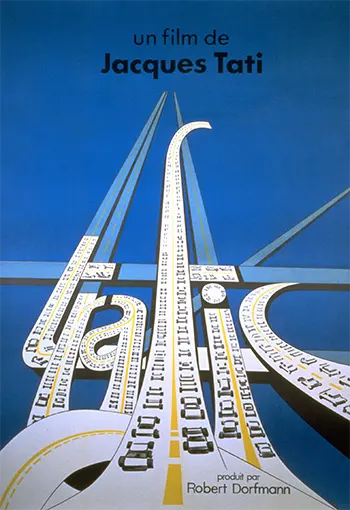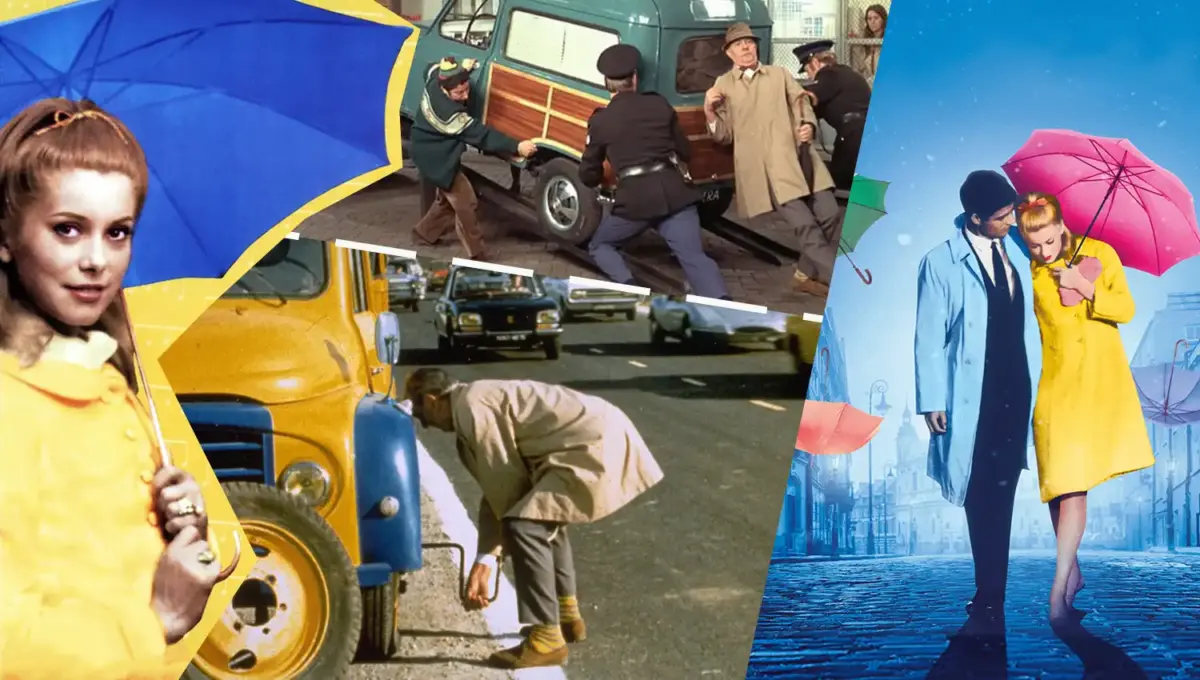The Umbrellas of Cherbourg (Les Parapluies de Cherbourg)
(1964)

This is the movie where every word is sung. I honestly wasn’t sure I’d like that. Or make it through to the end. After all, the only place where they sing every word, all the time, is opera. Which is not really my thing.
But this is not opera. And, yes, it takes a bit getting used to the singing. Even when it’s as simple as “Hello, how are you today?” After a few minutes, it makes sense though. Simply part of a feeling of other-worldliness. Unusual, yet somehow so appropriate.
Because of this different treatment, I become more aware, more focused on the story and what’s happening on screen.
The sung dialog may be different, but everything else in the movie is quite realistic. Down to very bold and very late 1950s/early 1960s wallpaper. Cherbourg feels very tangible. It’s not simply some movie set in fantasyland. It feels like a place I might have grown up in. Or could visit.
The film tells the story of Guy (Nino Castelnuovo), a young garage mechanic, and Geneviève (Catherine Deneuve), the 17-year old daughter of Madame Émery, the perennially pecuniarily challenged owner of a small umbrella shop. While there’s plenty of rain in Cherbourg, the shop doesn’t seem to do much business. Foreclosure is hanging over Madame.
Guy and Geneviève are in love. The odds are already stacked against them, with him being a lowly car mechanic and her needing to marry into money to support Maman in the style to which she fancies herself accustomed. That’s enough to derail any first love.
Add to that Guy being drafted into the army. Not just regular military training, but off to combat. Because France is at war in Algeria. He goes away with a mutual promise to write. Letters will keep their young love blossoming.
Or not.
First love is full of energy and joy, but also ever so fragile. As the film progresses, it explores the 2 young lovers’ separation, their feelings for the absent person and the realities of day-to-day. Will their love conquer all? Or is it doomed? We, the audience, root for them in the face of everything stacking up against them.
Maybe the singing helps us get deeper in touch with the characters’ emotions. In a different way from if the dialog was simply spoken.
This film comes out of the French New Wave cinema of the 1950s. Films exploring new ways of telling stories. Which this movie does in a visually stunning manner. At the same time managing to be both real and tender.
While we haven’t seen a rash of films with entirely sung dialog, The Umbrellas of Cherbourg left a mark and became a classic, influencing filmmaking in the decades since it was made. Maybe most spectacularly by being a major inspiration for Damien Chazelle when he conceived and created his musical La La Land.
Chazelle claims to have seen the movie more than 200 times: “I’m not the only one who cries during this movie. … It hits you like a ton of bricks.”
Maybe it’s not that far from always sunny California to the seemingly perennially rainy streets of Cherbourg.
And who hasn’t experienced first love and all the elation and turmoil that goes with it? There’s a bit of Guy and Geneviève in most (all) of us.
Trafic
(1971)

Mention Jaques Tati and many people think of his 1958 Mon Oncle (My Uncle) where Monsieur Hulot is trying to make sense of modernism and consumerism. Or the scene at a train station in Mr Hulot’s Holiday (1953) where hapless vacation travelers are sent scurrying back and forth between platforms by an utterly unintelligible loudspeaker.
In Trafic we again encounter Mr. Hulot. Now he’s a car designer for the up-and-coming auto manufacturer Alta. At least it will be up-and-coming if they can only get their brand-new, ingenious and very compact camping car to Amsterdam for the big, international car show.
The one where orders will flood in once people see how wonderful the Alta camping car is.
The premise is so simple: Load the prototype camping car onto a truck. Drive said truck from Paris to Amsterdam (which is all in a day’s work). Set up the Alta booth at the international automobile show and present this new, convenient world of compact and mobile camping to show visitors. Hand out brochures and take orders. Success is bound to follow.
There’s the slightly inept truck driver. Plus the highly confident and energetic “I am Public Relations” Maria who breezes in to take charge (and has a seemingly endless supply of situation-appropriate, very stylish outfits stashed in her roadster).
But most of all, there’s Monsieur Hulot. We get the feeling he’d much prefer to stay at his drawing board, thinking up the next version of the camping car. Or perhaps a sports car with built-in picnic set, food storage and wine cellar.
Turns out the road to Amsterdam is far more complicated than simply point the truck and drive. Because just about anything that could go wrong does on this road trip.
It’s a heart-warming movie that not only finds, but diligently seeks out, the funny and absurd in our increasingly busy and stressed modern world of technology. It was spot-on in 1971. Car models and fashion styles have changed a lot since then, but it’s still amazingly spot-on in 2023.
Except of course we’ve added always-on interconnectedness. There are hilarious scenes of people in cars stuck in traffic exploring what they do in their “private” space inside the car when nothing is moving. The same scene today would include all the same things, plus a high number of those people attached to their mobile devices. Now even more oblivious to their surroundings.
As in other Tati movies, large parts of the story are told without words. Through actions, gestures and manners. Also timing and contrast. With plentiful sprinklings of absurd. Which is all very refreshing and makes for both enjoyable watching and poignant storytelling.
All the while, the movie also leads us to question this striving for always more, always newer. 1971 was a time of unbridled consumerism and little thought for where all of yesterday’s discards would go. (Although, how different is that from today, really?)
It’s a recurring theme for Tati: characters struggling with modernity, technology and rampant consumerism. But he also leaves us a glimmer of hope through all the everyday people appearing along the road and the relationships that evolve. In the midst of all the relentless modernity, it’s still human connections that will carry us forward and give life purpose.
2 films about people, relationships and a changing world. One that is becoming ever more complex, crowded and rushed. Where there seems to be no room for a small umbrella shop or an upstart auto maker.
Both movies take unconventional approaches to story telling. One is full of words, all sung, which fundamentally changes how we perceive and interact with the story.
The other goes for long stretches without words and when they’re used, economizes. Yet tells a very powerful story, full of meaning, undercurrent and texture.
This unconventional story telling also challenges us as to how we see the everyday world around us. Am I stuck in a rut as far as interpreting events around me or am I looking at them with fresh eyes, from different perspectives?
Because when we do the latter, we’re able to make better choices in relationships and in how we interact with technology — in short, making sense of life.


